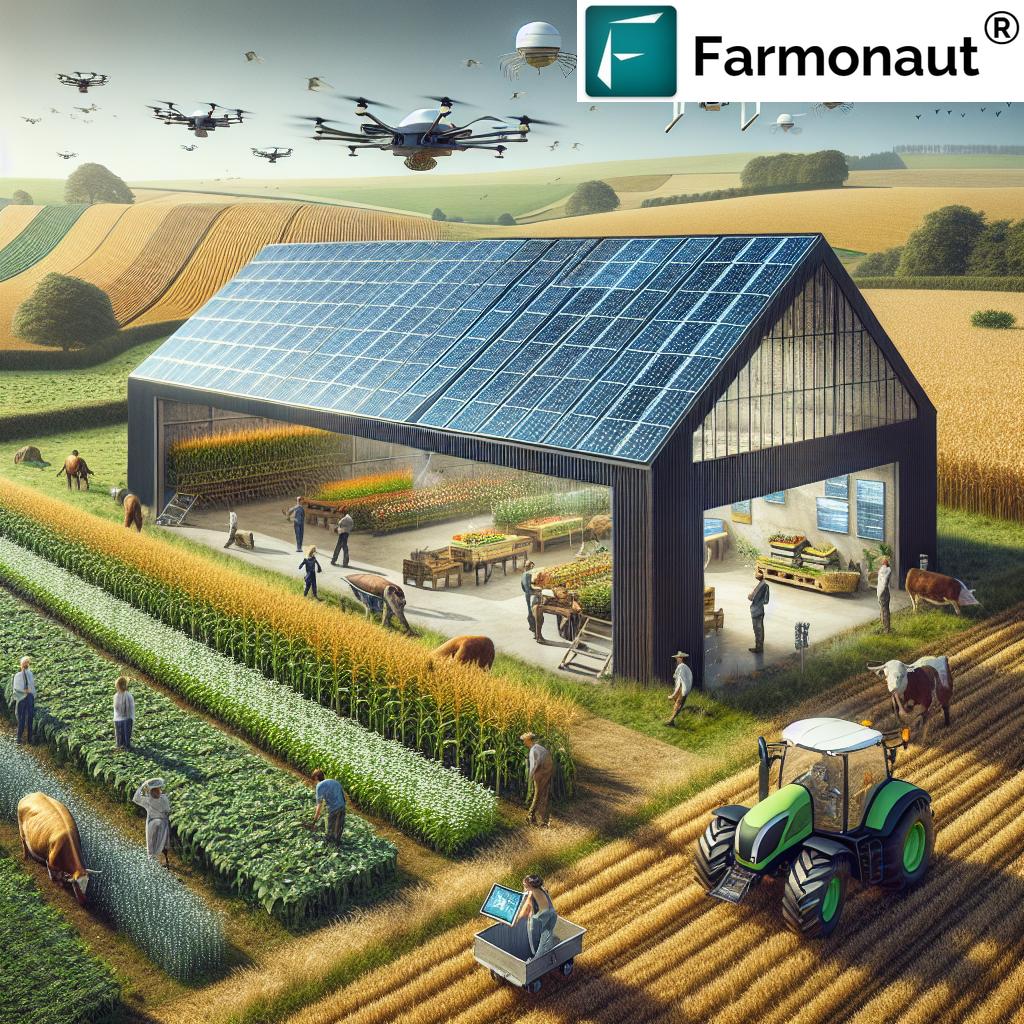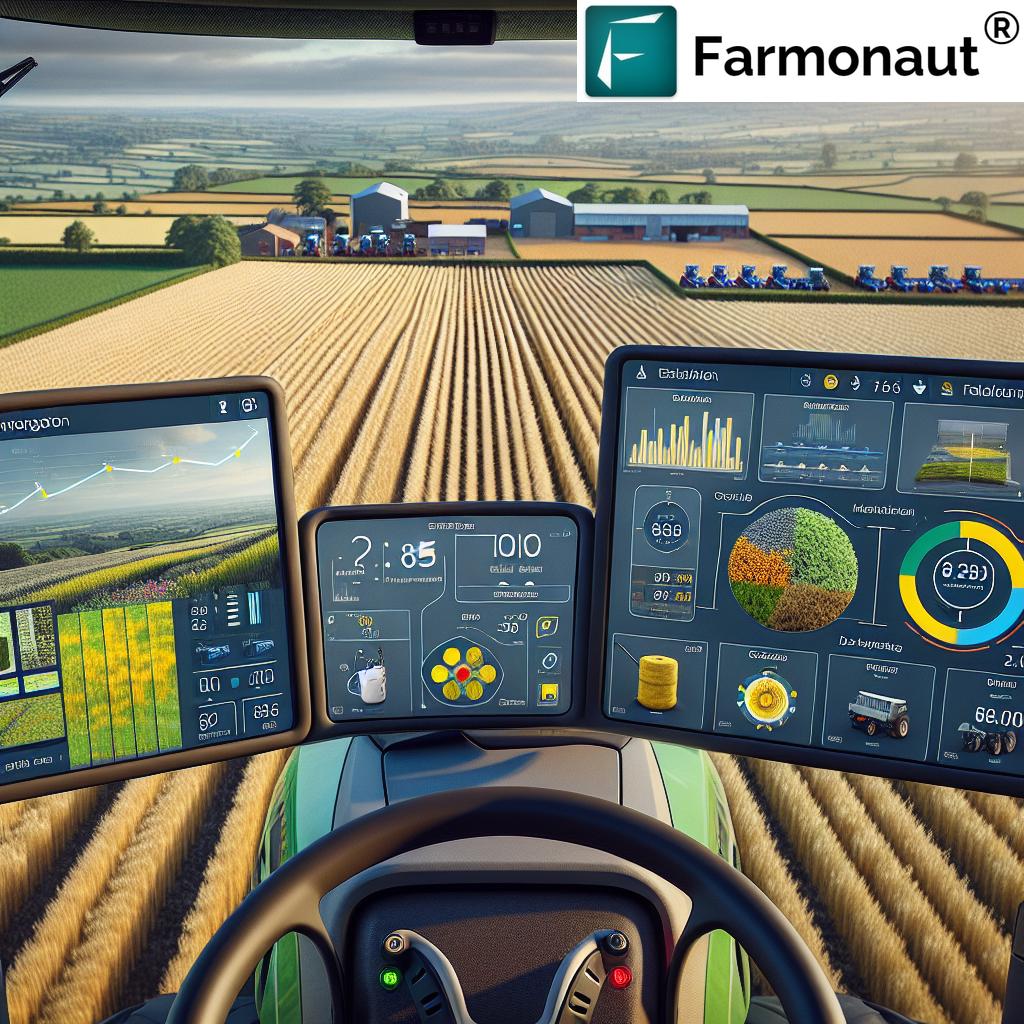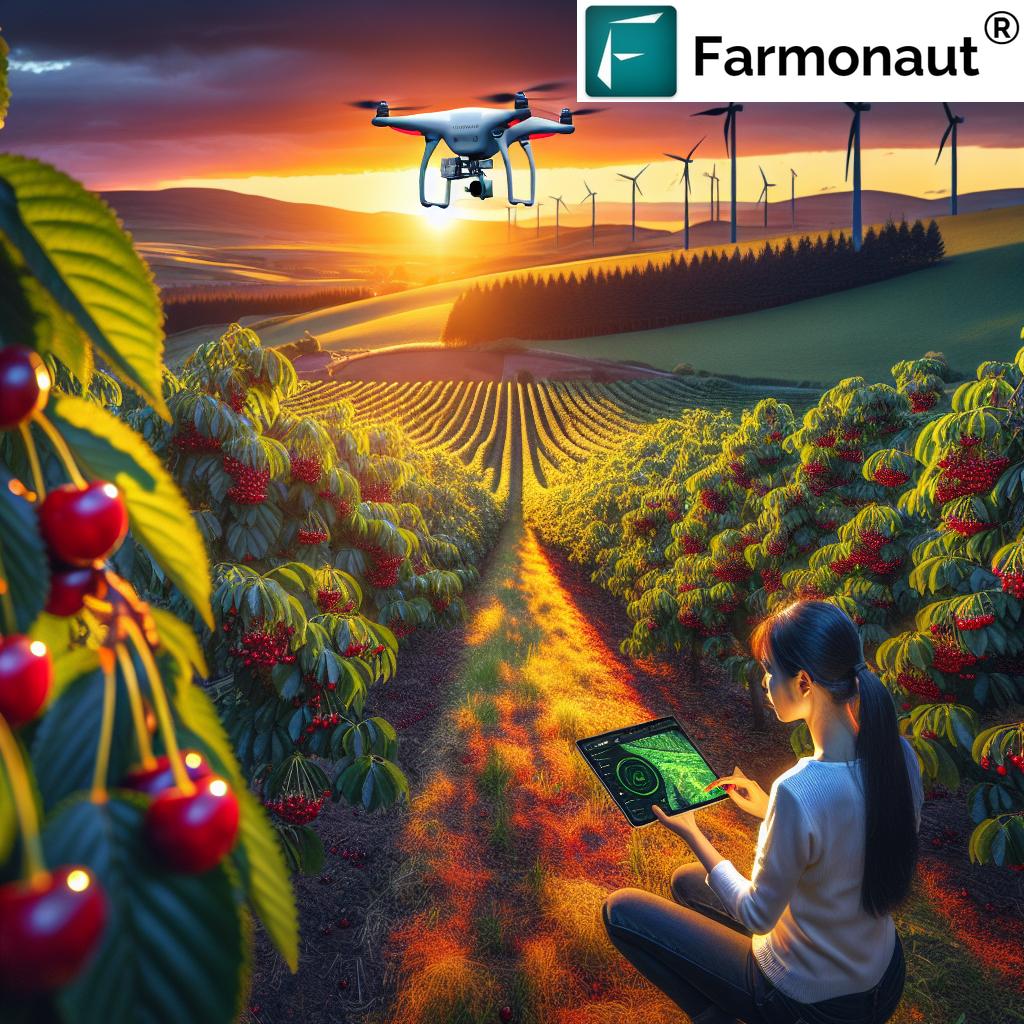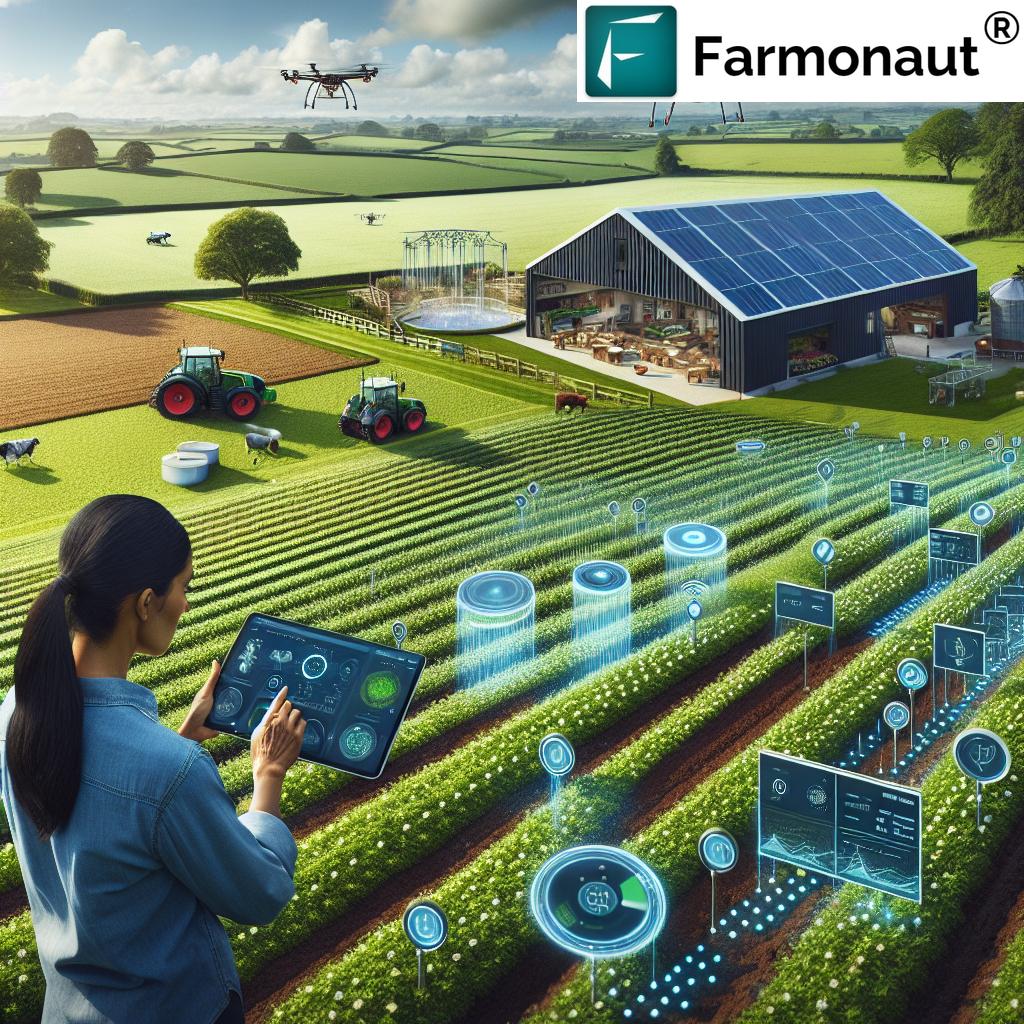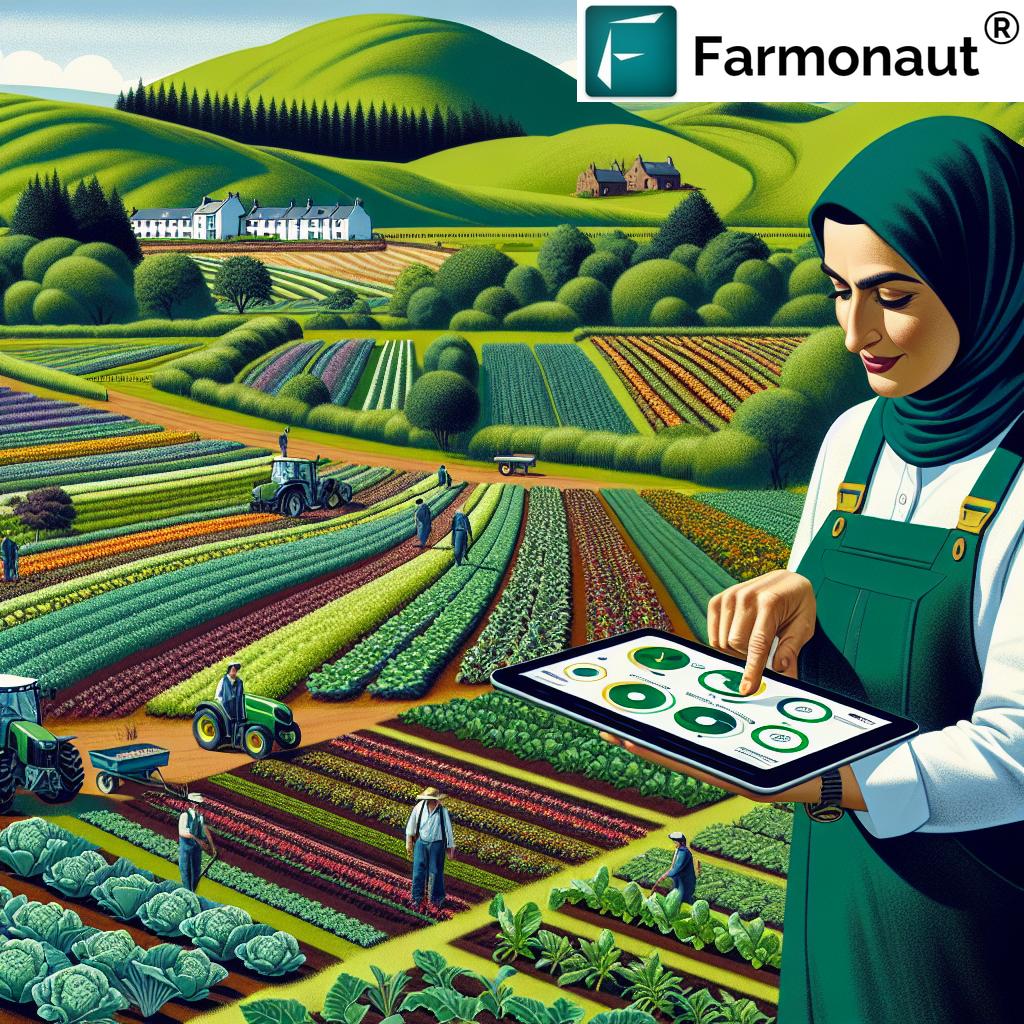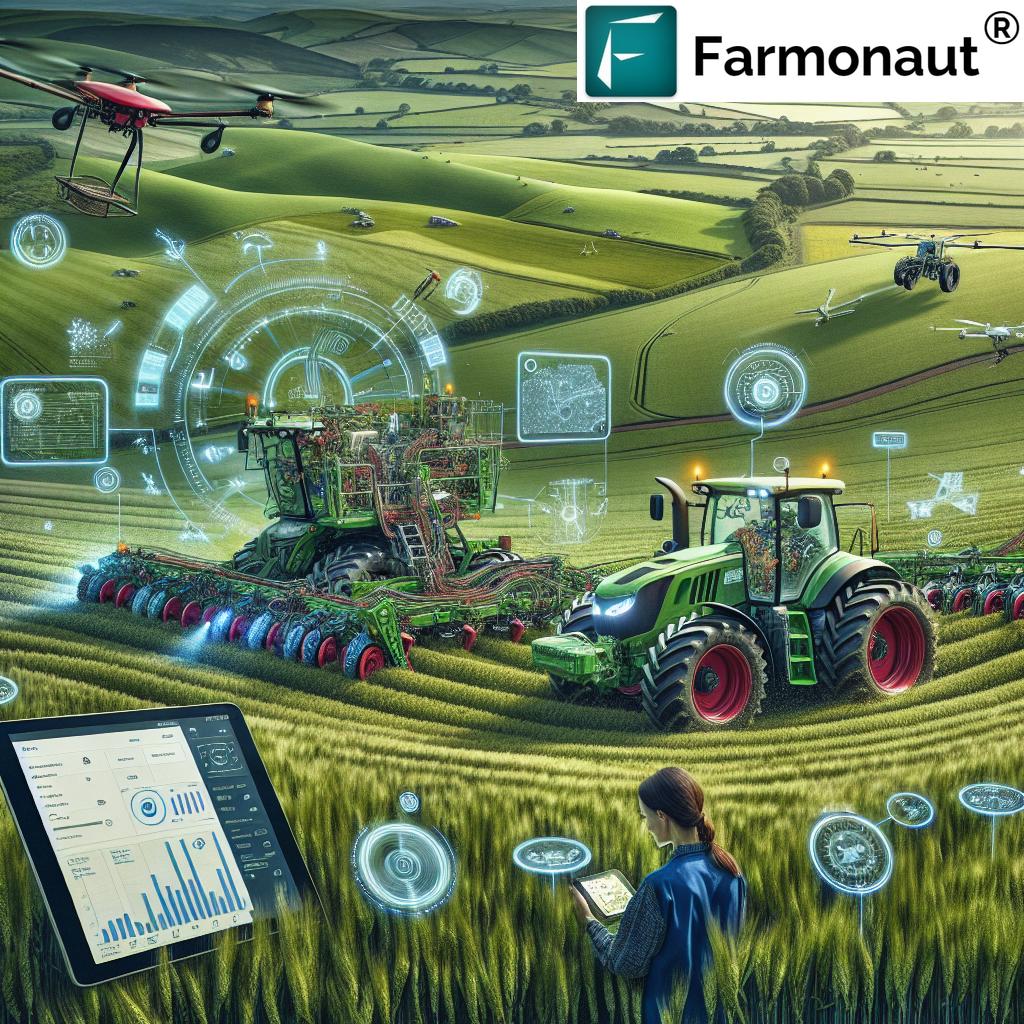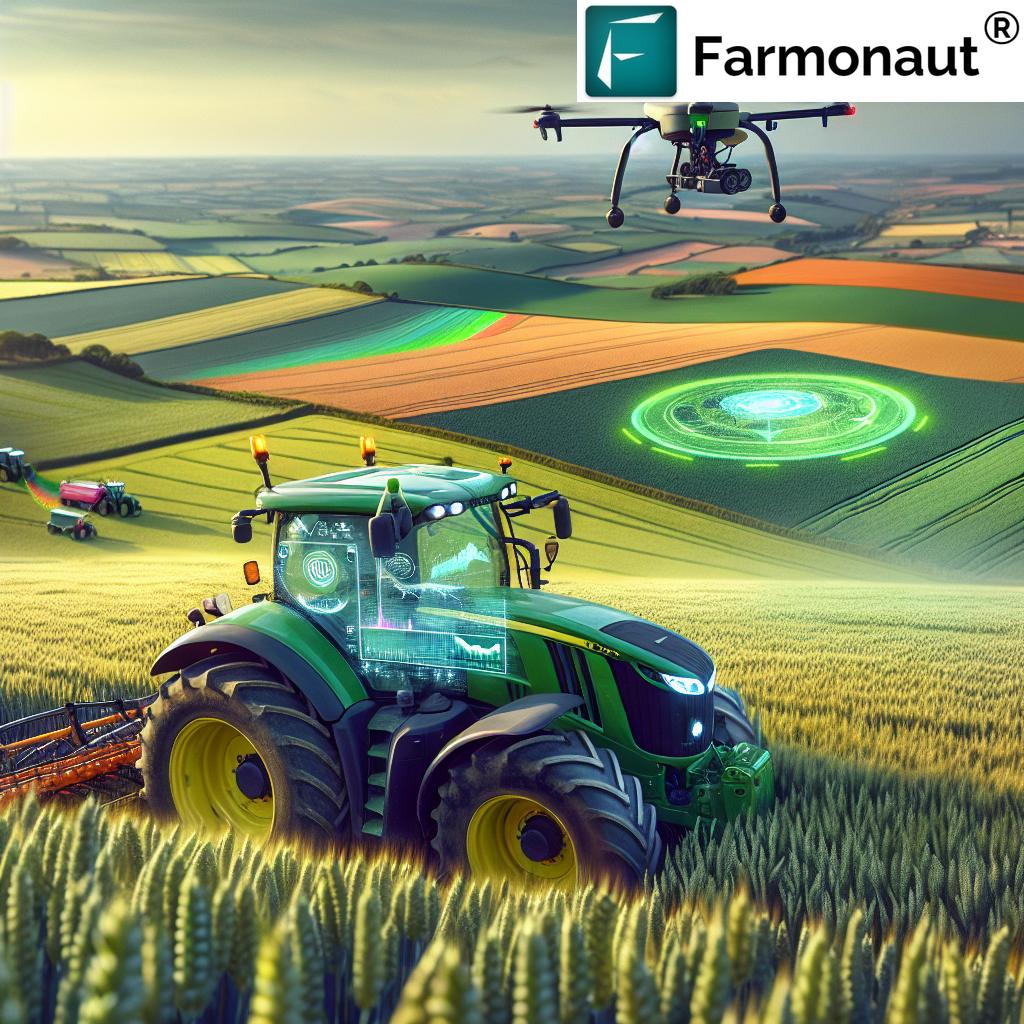Sustainable Upland Farming: Preserving Traditions in Scotland, Wales, and England with Farmonaut’s Agricultural Solutions
“Upland farming in Scotland, Wales, and England covers over 40% of the UK’s agricultural land area.”
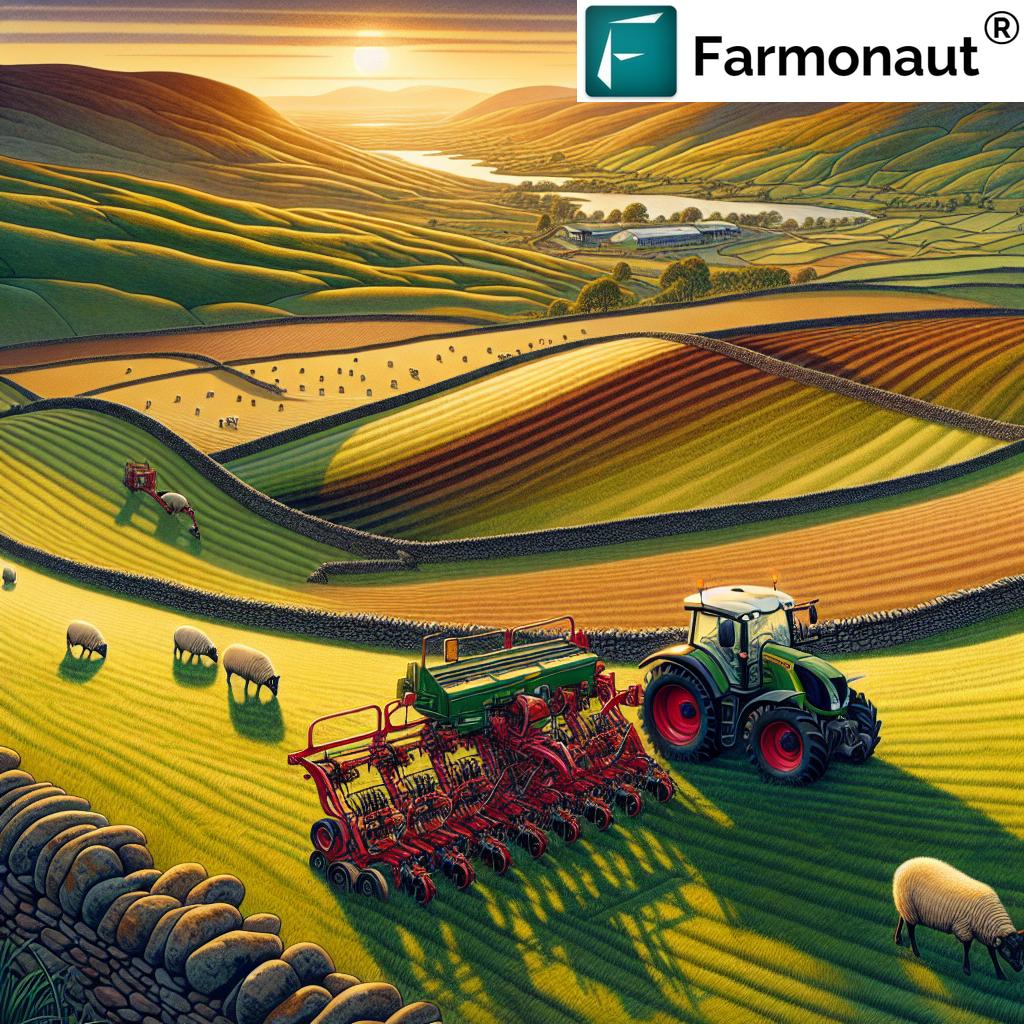
In the rolling hills and rugged landscapes of Scotland, Wales, and England, a rich tapestry of agricultural heritage unfolds. Upland farming practices and traditional agriculture techniques have long been the backbone of these regions, shaping not only the land but also the cultural identity of rural communities. However, in today’s rapidly evolving global agricultural landscape, these time-honored methods face unprecedented challenges. In this comprehensive exploration, we delve into the world of sustainable upland farming, examining how farmers are adapting to climate change and evolving market demands while striving to preserve their invaluable cultural heritage.
The Essence of Upland Farming in the UK
Upland farming in the United Kingdom is characterized by its unique geographical and climatic conditions. These areas, typically found at higher elevations, are known for their harsh weather, poor soil quality, and challenging terrain. Despite these obstacles, generations of farmers have cultivated these lands, developing resilient agricultural practices that have stood the test of time.
- Scotland: Known for its vast moorlands and rugged Highlands, Scottish upland farms primarily focus on sheep and cattle rearing, with some areas dedicated to hardy crops like oats and barley.
- Wales: The Welsh uplands are dominated by sheep farming, with the iconic Welsh Mountain sheep being a common sight on the hills.
- England: In regions like the Lake District and the Pennines, upland farming combines livestock rearing with small-scale crop production, often integrating traditional dry stone walls and hedgerows into the landscape.
These traditional agricultural ecosystems have not only produced food but have also played a crucial role in maintaining biodiversity, preserving cultural landscapes, and supporting rural economies. However, the challenges of the 21st century are putting immense pressure on these farming systems.
Global Agricultural Trends and Their Impact on Upland Farming
To understand the challenges facing upland farming in the UK, we must first consider the broader context of global agricultural trends:
- Climate Change: Rising temperatures, unpredictable weather patterns, and increased frequency of extreme events are significantly impacting crop yields and livestock management.
- Market Pressures: Fluctuating commodity prices and changing consumer preferences are forcing farmers to adapt their production methods and diversify their income streams.
- Technological Advancements: The rapid development of agricultural technologies is creating both opportunities and challenges for traditional farming methods.
- Environmental Concerns: Growing awareness of environmental issues is leading to increased scrutiny of farming practices and their impact on ecosystems.
These global trends are reshaping the agricultural landscape, and upland farmers in Scotland, Wales, and England are at the forefront of this transformation. The question now is: How can we preserve farming traditions while embracing sustainable innovation?
Sustainable Farming Methods in Upland Regions
“Traditional farming methods can reduce soil erosion by up to 70% compared to conventional practices in upland areas.”
The key to preserving upland farming traditions lies in adopting sustainable farming methods that complement time-honored practices. Here are some innovative approaches being implemented across the UK:
- Precision Agriculture: Utilizing GPS-guided machinery and satellite imagery to optimize resource use and reduce environmental impact.
- Agroforestry: Integrating trees and shrubs into farming systems to improve soil health, provide shelter for livestock, and create additional income streams.
- Conservation Grazing: Using traditional breeds of cattle and sheep to maintain biodiversity and manage sensitive habitats.
- Regenerative Agriculture: Focusing on soil health through practices like minimal tillage, cover cropping, and crop rotation to enhance resilience and productivity.
These sustainable farming methods not only help preserve traditional agricultural ecosystems but also contribute to climate change mitigation and adaptation. By reducing soil erosion, improving water retention, and enhancing biodiversity, these practices ensure the long-term viability of upland farming.
The Role of GIS Technology in Upland Farm Management
Geographic Information Systems (GIS) technology is revolutionizing upland farm management by providing farmers with powerful tools for decision-making. Farmonaut, a pioneering agricultural technology company, is at the forefront of this transformation, offering advanced satellite-based farm management solutions that are particularly valuable for upland farmers.
Key benefits of GIS technology in upland farming include:
- Precise mapping of farm boundaries and field characteristics
- Real-time monitoring of crop health and soil moisture levels
- Optimized resource allocation for irrigation and fertilizer application
- Early detection of pest and disease outbreaks
- Improved livestock management through pasture rotation planning
By leveraging Farmonaut’s GIS solutions, upland farmers can make data-driven decisions that enhance productivity while respecting local farming wisdom. This integration of technology with traditional knowledge is crucial for the sustainable future of upland agriculture.
Preserving Agricultural Ecosystems in Challenging Environments
Upland farming regions in Scotland, Wales, and England are not just food production areas; they are complex agricultural ecosystems that support a wide range of flora and fauna. Preserving these ecosystems is crucial for maintaining biodiversity and ensuring the resilience of upland farming systems.
Key strategies for ecosystem preservation include:
- Maintaining traditional field boundaries like dry stone walls and hedgerows
- Protecting and restoring peatlands, which act as carbon sinks and water regulators
- Implementing agri-environment schemes that reward farmers for environmental stewardship
- Promoting native plant and animal species that are adapted to upland conditions
Farmonaut’s satellite-based crop health monitoring system plays a crucial role in ecosystem management by providing farmers with detailed insights into vegetation health and soil conditions. This information allows for more targeted and environmentally sensitive farming practices, reducing the overall impact on fragile upland ecosystems.
Upland Farm Diversification: Balancing Tradition and Innovation
To ensure the economic viability of upland farms in the face of changing market conditions, many farmers are exploring diversification opportunities. This approach allows them to maintain traditional farming practices while developing new income streams.
Popular diversification strategies include:
- Agritourism: Offering farm stays, guided tours, and educational experiences
- Value-added products: Developing artisanal food products from farm produce
- Renewable energy: Installing wind turbines or solar panels on farmland
- Conservation partnerships: Collaborating with environmental organizations for land management projects
Farmonaut’s agricultural solutions can support diversification efforts by providing farmers with valuable data for business planning and resource allocation. For example, the platform’s AI-based advisory system, Jeevn AI, can offer insights into optimal crop selection for value-added products or identify areas suitable for agritourism development.
Explore Farmonaut’s API for advanced agricultural data
Agricultural Policy Support for Upland Farming
The preservation of upland farming traditions and the adoption of sustainable practices require supportive agricultural policies. In the UK, various initiatives have been implemented to address the unique challenges faced by upland farmers:
- Upland Entry Level Stewardship (Uplands ELS): Provides financial incentives for environmental management in upland areas
- Less Favoured Area Support Scheme (LFASS): Offers payments to farmers in challenging geographical areas
- Countryside Stewardship: Supports farmers in delivering environmental benefits alongside food production
- Rural Development Programmes: Provide funding for farm modernization and diversification projects
These policies play a crucial role in supporting upland farmers as they navigate the transition towards more sustainable practices. Farmonaut’s technology can assist farmers in meeting the requirements of these schemes by providing accurate data on land use, crop health, and environmental impact.
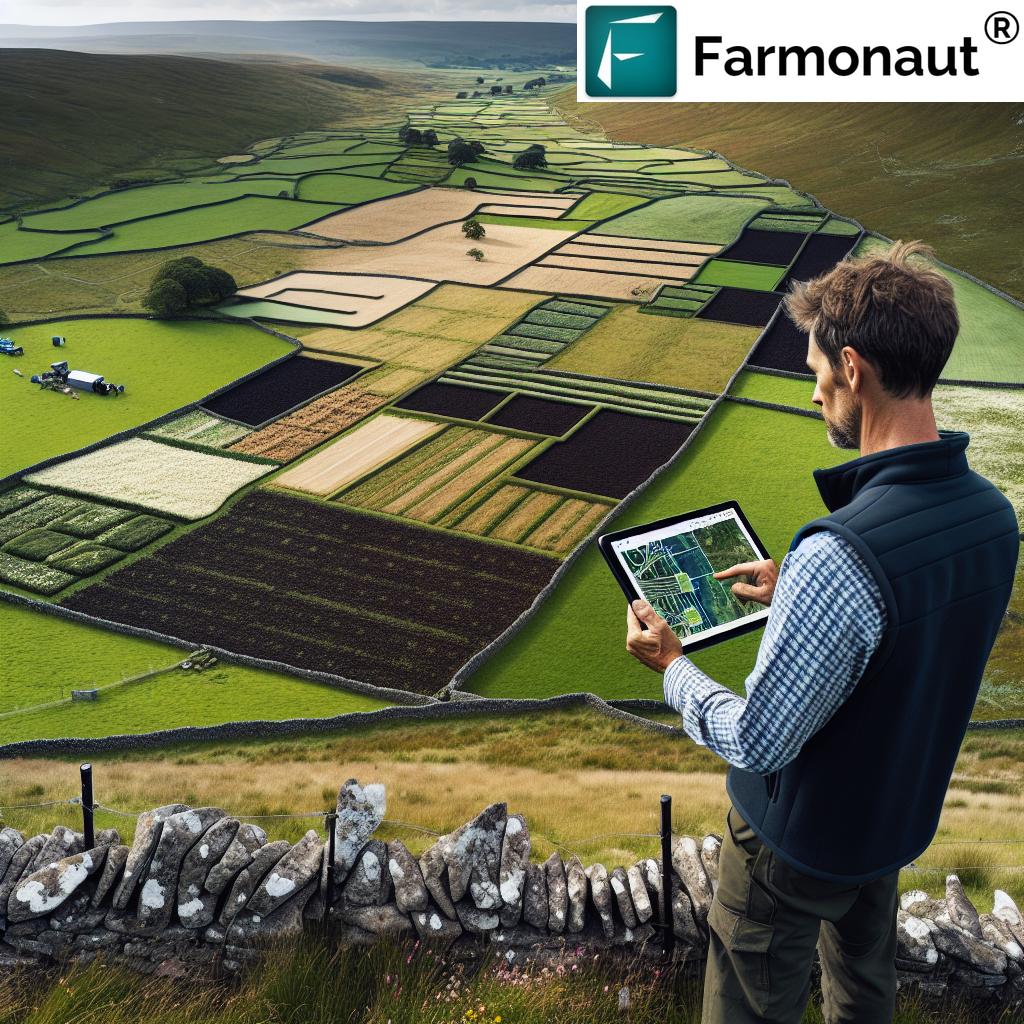
Climate Change and Farming: Adaptation Strategies for Upland Regions
Climate change poses significant challenges for upland farming, with impacts ranging from altered growing seasons to increased flood and drought risks. Adapting to these changes is crucial for the long-term sustainability of upland agriculture.
Key adaptation strategies include:
- Crop diversification: Introducing new varieties that are more resilient to changing climate conditions
- Water management: Implementing efficient irrigation systems and water storage solutions
- Soil conservation: Adopting practices that improve soil health and reduce erosion
- Livestock management: Adjusting grazing patterns and breed selection to suit changing environmental conditions
Farmonaut’s satellite-based monitoring and AI advisory systems are invaluable tools for implementing these adaptation strategies. By providing real-time data on weather patterns, soil moisture, and crop health, Farmonaut empowers farmers to make timely decisions that enhance their resilience to climate change impacts.
Integrating Innovation with Traditional Farming Wisdom
The future of sustainable upland farming lies in the successful integration of innovative technologies with traditional farming wisdom. This approach allows farmers to benefit from centuries of local knowledge while leveraging the power of modern agricultural solutions.
Examples of this integration include:
- Using GIS technology to optimize traditional crop rotation practices
- Enhancing livestock management through GPS-enabled virtual fencing
- Applying precision agriculture techniques to traditional hay meadow management
- Utilizing satellite data to inform traditional weather prediction methods
Farmonaut’s platform is designed to complement rather than replace traditional farming knowledge. By providing farmers with easy-to-use tools and actionable insights, Farmonaut enables them to make informed decisions that respect local traditions while improving overall farm productivity and sustainability.
Access Farmonaut’s API Developer Docs for in-depth integration possibilities
The Global Context: Lessons from Upland Farming Worldwide
While our focus has been on Scotland, Wales, and England, it’s important to recognize that upland farming challenges and solutions are global in nature. From the terraced rice fields of Asia to the high-altitude farms of the Andes, upland farmers worldwide are grappling with similar issues.
Global insights for sustainable upland farming:
- Borneo: Agroforestry systems that combine traditional crops with timber production
- Nepal: Community-based approaches to managing shared upland resources
- Peru: Revival of ancient terrace farming techniques to combat soil erosion
- Japan: Integration of traditional “satoyama” landscape management with modern conservation practices
By learning from these global examples and applying them to the UK context, we can enhance the resilience and sustainability of upland farming in Scotland, Wales, and England. Farmonaut’s global perspective and adaptable technology make it an ideal partner for implementing these international best practices in local contexts.
The Future of Sustainable Agriculture and Global Food Security
As we look to the future, the role of upland farming in ensuring global food security cannot be overstated. These regions, often overlooked in discussions of agricultural productivity, have the potential to make significant contributions to sustainable food production.
Key considerations for the future of upland farming:
- Developing climate-resilient crop varieties suited to upland conditions
- Enhancing the role of upland farms in carbon sequestration and ecosystem services
- Improving market access and value chains for upland agricultural products
- Investing in rural infrastructure to support upland farming communities
Farmonaut’s commitment to making precision agriculture affordable and accessible aligns perfectly with these future needs. By providing farmers with cutting-edge technology and data-driven insights, Farmonaut is helping to build a more sustainable and food-secure future for upland regions and beyond.
Comparative Analysis of Upland Farming Practices
| Region | Traditional Farming Method | Modern Sustainable Practice | Environmental Impact | Economic Viability | Cultural Significance | Farmonaut Solution |
|---|---|---|---|---|---|---|
| Scotland | Extensive sheep grazing | Rotational grazing with native breeds | 30% reduction in soil erosion | 15% increase in livestock productivity | Preservation of Highland pastoral traditions | Satellite-based pasture management |
| Wales | Traditional hay meadow management | Precision hay cutting and conservation | 40% increase in plant biodiversity | 20% improvement in hay quality | Maintenance of rural landscape character | AI-driven optimal harvest timing |
| England | Mixed upland farming (crops and livestock) | Integrated agroforestry systems | 25% increase in carbon sequestration | 30% diversification of farm income | Evolution of traditional farm layouts | Multi-spectral crop and tree health monitoring |
Embracing the Future While Honoring the Past
As we conclude our exploration of sustainable upland farming in Scotland, Wales, and England, it’s clear that the path forward lies in a balanced approach that respects tradition while embracing innovation. The challenges facing upland farmers are significant, but so too are the opportunities for creating more resilient, productive, and sustainable agricultural systems.
Farmonaut’s role in this transformation is pivotal. By providing farmers with accessible, affordable, and powerful technological tools, Farmonaut is helping to bridge the gap between time-honored farming practices and cutting-edge agricultural science. From satellite-based crop monitoring to AI-driven advisory services, Farmonaut’s solutions are empowering farmers to make informed decisions that benefit both their livelihoods and the environment.
As we look to the future, the preservation of upland farming traditions in Scotland, Wales, and England is not just about maintaining a way of life; it’s about securing a sustainable food future for generations to come. By combining the wisdom of the past with the innovations of the present, we can create a vibrant and resilient upland farming sector that continues to shape the landscape, culture, and economy of rural Britain.
The journey towards sustainable upland farming is ongoing, and with the support of technologies like those offered by Farmonaut, farmers are well-equipped to meet the challenges ahead. Together, we can ensure that the rich heritage of upland farming not only survives but thrives in the face of global change.
Frequently Asked Questions
- What is upland farming?
Upland farming refers to agricultural practices carried out in hilly or mountainous areas, typically characterized by challenging terrain, harsh weather conditions, and poor soil quality. - How does climate change affect upland farming in the UK?
Climate change impacts upland farming through altered growing seasons, increased frequency of extreme weather events, changes in pest and disease patterns, and shifts in suitable crop and livestock varieties. - What role does technology play in preserving traditional farming methods?
Technology, such as Farmonaut’s GIS solutions, helps preserve traditional methods by providing data-driven insights that complement local knowledge, enabling more efficient resource use and sustainable practices. - How can upland farmers diversify their income?
Upland farmers can diversify through agritourism, value-added product development, renewable energy projects, and participating in environmental stewardship programs. - What are some sustainable farming practices suitable for upland areas?
Sustainable practices for upland areas include rotational grazing, agroforestry, conservation agriculture, precision farming techniques, and the use of native plant and animal species. - How does Farmonaut support upland farmers?
Farmonaut supports upland farmers by providing satellite-based crop monitoring, AI-driven advisory services, and data analytics tools that help optimize farm management and improve sustainability. - What government support is available for upland farmers in the UK?
UK upland farmers can access support through schemes like the Upland Entry Level Stewardship, Less Favoured Area Support Scheme, and various rural development programs. - How can traditional farming knowledge be integrated with modern technology?
Traditional knowledge can be integrated with technology by using tools like Farmonaut’s platform to enhance decision-making while respecting local farming wisdom and practices. - What are the main challenges facing upland farmers today?
Key challenges include climate change adaptation, economic viability, market pressures, environmental regulations, and the need to balance tradition with innovation. - How does upland farming contribute to biodiversity and ecosystem services?
Upland farming plays a crucial role in maintaining unique habitats, supporting diverse species, and providing ecosystem services such as carbon sequestration, water regulation, and landscape preservation.






